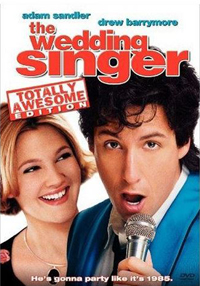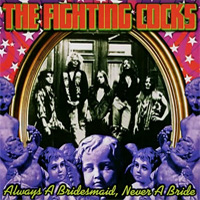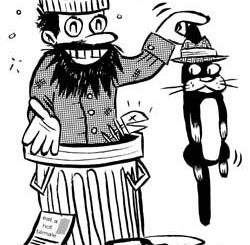 The Wedding Singer
The Wedding Singer
with Adam Sandler, Drew Barrymore
Directed by Frank Coraci
by Scott Hefflon
The Wedding Singer is a magical movie. It could be called a “chick movie” or an “inaccurate exploitation of ’80s nostalgia” or a closet romantic’s excuse to see a fully-clothed Drew Barrymore be really, really cute. Whatever your reason, it’s hard to dislike this movie. That is, unless you think instead of feel. Put it this way, The Wedding Singer is about as formulaic as you can get: boy meets girl, boy and girl fall for each other but they’re committed to others, they pal around while hiding their feelings, they finally get together and the credits roll as you sniff and pretend you’ve got something in your eye. Anyone who expects good dialogue in a love movie has never thought about what they say when they’re in love. We buy Hallmark cards that express our sentiments exactly, so what’s that say? The words “I love you” aren’t profound, nor are they original, but they can melt hearts.
The Wedding Singer is set in the mid-’80s instead of Medieval times like The Princess Bride, and while Sandler ain’t no witty swashbuckler matching steel with revenge-driven Spaniards or grappling with one-man brute patrol, Andre the Giant, he’s the charming guy with a great voice who sang funny songs on Saturday Night Live. And while there’s something about Drew Barrymore, her fashion and dialogue don’t fit the setting. Not that any of us really care. And while the soundtrack to The Wedding Singer brings back all those memories of childhood innocence and the race to lose it, the movie is far from a ’90s remake of The Breakfast Club. It’s closer than Can’t Hardly Wait, but for different reasons. In The Wedding Singer, everyone’s already out of high school, yet they still buy into the themes, values, music, and fashions of the time. Sandler’s sidekick wears a white, sequined glove to a bridal shower until Sandler mentions it makes him look like a psycho. And this guy is a guy, as in a man, as in a mid-twentysomething with a Fonzie complex who wears fake leather pants and those terrible Michael Jackson jackets while trying to scoop impressionable young chicks. It’s funny cuz it’s so pathetic and we all used to know guys like that. Sandler is at least a slightly more somber cheeseball, and Barrymore, as previously mentioned, wears cutie-pie clothing that may’ve never been in style but have always been worn.
Can’t Hardly Wait, on the other hand, may be true to The Breakfast Club‘s representation (one character per stereotype, please) of high school in the late ’90s, the difference being none of the characters have clever one-liners, recognizable and soon-to-be-imitated characteristics, and on the whole, exemplify a pretty interchangeable bunch of shallow parodies of teen drama with characters you feel little sympathy for. The tough jock gets a heart, but only after losing popularity, which he trades back the first chance he gets. The lust-interest is cute, but not desirable as anything other than a wallet photo to look back on in future years when life sucks even more than in high school, and the rest of the friends and fellow last-bash attendees are the room-filling ignorables you hope never breed, or at least you’ll never run into again. The only interesting character in the movie is the dweeb-gone-nuts, and that’s only cuz he finally gets drunk. Like the jock, he returns to normal as soon as the night’s over. All this leads to but one conclusion: Either ’80s teen movies were better than ’90s teen movies, or ’80s kids were just plain more interesting than ’90s kids. Ethan somethingorother (Empire Records, any questions?) ain’t no quirky, charming dweeb like Anthony Michael Hall (Weird Science, Sixteen Candles, etc.). He’s just a one-dimensional sap. And his one-dimensional platonic, kinda-attractive-in-a-chubby-way female friend (one of the not-very-interesting kids in In & Out) sure as shit ain’t no drum-playing tomboy like butchy-yet-adorable Mary Stuart Masterson in Some Kind of Wonderful (again, Eric Stoltz was a complex, love-struck lad, while Lea Thompson was yet another in a long string of cute, perky cut-outs). I’d ask if women get pissed cuz their ideal (or a male’s portrayal of their ideal) is always represented as a misunderstood prom queen, but that probably explains why everyone rallied around Joey Lauren Adams in Chasing Amy – finally a complex woman and a cute-yet-forgettable guy (Ben Affleck), although the guy got far too much screen time as though we gave a shit what he thought and felt.
While Sandler may be prone to screwing up his mouth and whining and stumbling like a lost puppy when put on the spot, he plays a kind-hearted guy and a helluva’n entertainer on stage. (Was anyone besides me bothered that all the promo shots with him singing into a microphone look kinda like gay porn stills?) But that duality, that on versus off-stage personality conflict, is what makes musicians and artists such great choices for leads in these roles. I’m afraid to see MTV’s Varsity Blues for that exact reason. I saw beefed-up Anthony Michael Hall in Johnny Be Good – that’s not his best work, nor the story that should be retold!
In general, hell, Mallrats is one of the better, more realistic teen romances, but despite its clever dialogue, strong characters, and plenty of quotables and funny situations to reenact, it got bagged by critics and director alike! You just can’t fuckin’ win. To bring it all around, The Wedding Singer is a sweet movie and a goofy nostalgia trip. You should see it. And if you’ve already seen it, you should see it again.



